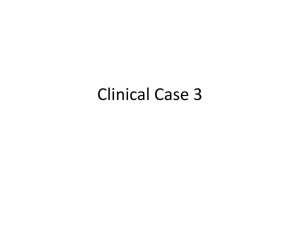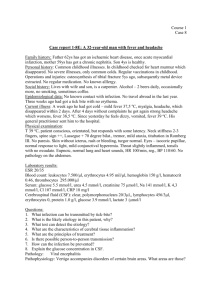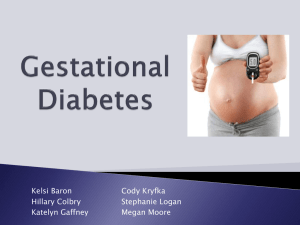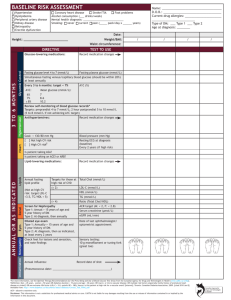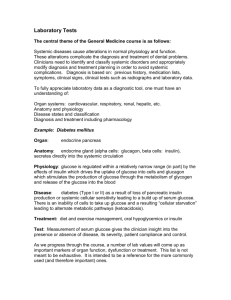Clinical Practice Guidelines for the management of Diabetes during pregnancy
advertisement
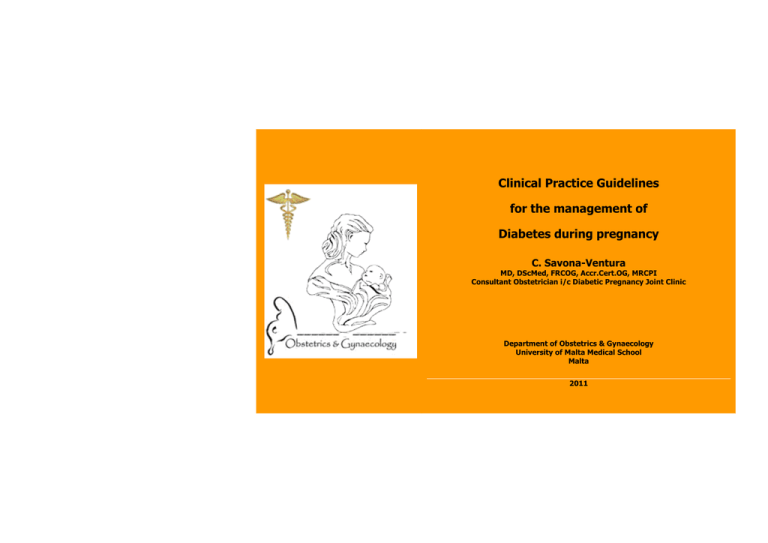
Clinical Practice Guidelines for the management of Diabetes during pregnancy C. Savona-Ventura MD, DScMed, FRCOG, Accr.Cert.OG, MRCPI Consultant Obstetrician i/c Diabetic Pregnancy Joint Clinic Department of Obstetrics & Gynaecology University of Malta Medical School Malta 2011 Published by Department of Obstetrics & Gynaecology University of Malta Medical School, Malta © Charles Savona-Ventura, 2011 No part of this publication may be reproduced, stored in a retrieval system or transmitted to any form by any means, electronic, mechanical, photocopying, recording or otherwise, without the previous permission of the publisher and author. 2 CONTENTS INTRODUCTION......................................................................................4 DIAGNOSTIC CRITERIA ...........................................................................5 SCREENING FOR GDM .............................................................................6 ANTENATAL MANAGEMENT......................................................................8 INTRAPARTUM MANAGEMENT................................................................ 16 POSTPARTUM MANAGEMENT ................................................................. 21 3 INTRODUCTION The Maltese population has repeatedly been shown to have a high high prevalence of DM/IGT, mainly of the Type 2 form.1 This high prevalence is reflected in the pregnant population. Epidemiological studies have suggested that the prevalence of diabetic disorders in the Maltese pregnant population approximates 6%, including a small proportion of pre-existing DM. In addition, a further 5.6% have elevated values that may reflect a tendency towards a relative hyperglycaemia with the possibility of adverse outcomes. 2 Clinical Severity % total pregnant population Pre-existing DM ……..# Type 1 DM 0.2% ……..# Type 2 DM – IGT – MODY 0.1% Gestational DM ……..# Severe GDM 0.7% ……..# Mild-Moderate GDM 5.2% Relative hyperglycaemia 5.6% Table 1: Prevalence rates of DM in Maltese Pregnant Population The figures quoted above are based on modified ADA diagnostic criteria, where Gestational Diabetes Mellitus [GDM] is defined as a 2-hour blood glucose value of >8.6 mmol/l after a 75 gram oral glucose tolerance test [oGTT]. Relative hyperglycaemia refers to 2-hour post-load values of 7.8-8.5 mmol/l [considered as mild GIGT by the WHO diagnostic criteria]. Recent modifications to diagnostic criteria based on the HAPO study that consider GDM as being present with any one abnormal value of a Fasting Blood glucose >5.1 mmol/l, 1-hour post load value of >10.0 mmol/l, and 2-hour post-load value of >5.1 mmol/l will significantly increase the GDM rate in the Maltese population to about 16.5%. 3 4 DIAGNOSTIC CRITERIA The overall diabetogenic effect caused by the physiological changes of pregnancy initiated in an attempt to facilitate nutrient transfer to the developing foetus has resulted in controversy relating to the true diagnostic criteria that need to be applied in order to diagnose GDM. Commonly referred to diagnostic criteria for the 75 gram oGTT, adopted at various times in Malta, include the WHO and the ADA criteria. More recently, the IADPSG have adopted more stringent criteria based on the HAPO study.4 75-gram oGTT values Fasting blood glucose mmol/l 1-hour blood glucose mmol/l 2-hour blood glucose mmol/l WHO >7.0 ADA* >5.3 >10.0 >8.6 >7.8 IADPSG >5.1 >10.0 >8.5 * two values need to be abnormal; in Malta – modified to one abnormal value Diagnostic criteria Clinical diagnosis Pre-Type 1DM Pre-Type 2 – Pre-IGT Pre-GDM Severe GDM Mild-moderate GDM Suspected GDM Definition Patients with a past history of carbohydrate metabolism problems occurring prior to pregnancy, whether dependent on insulin or not. Patients with a past history of carbohydrate metabolism problems during their previous pregnancies. These have been already diagnosed as insulin resistant and should not be submitted to an unnecessary glucose during their pregnancy. Fasting blood glucose >7.0 mmol/l 1 hour blood glucose >11.0 mmol/l 2 hour blood glucose >11.0 mmol/l any one abnormal result Fasting blood glucose >5.1 mmol/l 1 hour blood glucose >10.0 mmol/l 2 hour blood glucose >8.5 mmol/l any one abnormal result Patients suspected as suffering from GDM on clinical grounds but who did not have a diagnostic Oral glucose tolerance test performed. Working Clinical Definitions 5 SCREENING FOR GDM The high prevalence of gestational DM reported in the Maltese population makes routine screening with a 75-gram glucose load the ideal policy. However, cost-risk considerations still make the adoption of this screening option debatable. Repeated audit studies have shown that, in the Maltese context, the use of risk factors for screening appears to identify all the severe GDM cases, but only identify 25% of the mild-moderate GDM cases.5,6 Only 7.6% of Maltese pregnant women were referred for oGTTs during their pregnancy during 1999-2004.7 The current screening protocol in use based on historic-clinical risk factors is schematized below. Current Screening Protocol for Gestational Diabetes First Obstetric Visit Æcheck risk status Æ untimed RBG untimed RBG >=11.1 mmol/l 7.07.0-11.0 mmol/l <=6.9 mmol/l timed FBG >=6.1 mmol/l 4.64.6-6.0 mmol/l <4.6 mmol/l Consider normal if no clinical risk factors present 12:20:10 Risk Factors Consider normal if RBG/FBG normal Absent Consider as overt DM Present Recall for FBG Risk factors •Age >=40 yrs •Unexplained SB •P/H recurrent miscarriages •P/H BW >=4.0 kg •Weight >100 kg •P/H oligomenorrhoea •Strong maternal/sibling F/H oGTT after 24 weeks Consider as GDM if diagnostic criteria met Clinical Indicators •Polyhydramnios •Macrosomia •Recurrent fasting glucosuria oGTT diagnostic criteria Normal ÆoGTT not performed in: Known prepre-existing DM cases & Cases with P/H of GDM ÆAll cases of severe GDM should have postpartum followfollow-up for metabolic profiling GDM Severe GDM Fasting plasma glucose < 5.3 mmol/l 5.3-7.0 mmol/l >= 7.0 mmol/l 1-hour post load plasma glucose <10.0 mmol/l 10.0-11.0 mmol/l >=11.0 mmol/l 2-hour post load plasma glucose < 8.6 mmol/l 8.6-10.9 mmol/l >=11.0 mmol/l 6 The adoption of the IADPSG biochemical screening, though ideal, will have marked cost consequences. A modified biochemical screening protocol – including severe obesity as a risk factor and excluding screening with HbA1c and introducing lower fasting blood glucose thresholds based on local outcome studies 8 – is schematized below. This would require performing an oGTT in about 43% of pregnant women. It will pick out 12% of the population as suffering from GDM and fail to identify 3% of the population. Biochemical Screening for Gestational Diabetes modified from IADPSG guidelines, 2010 First Obstetric Visit Æ Check BMI oGTT diagnostic criteria GDM Severe GDM < 5.1 mmol/l 5.1-7.0 mmol/l >= 7.0 mmol/l 1-hour post load plasma glucose <10.0 mmol/l 10.0-11.0 mmol/l >=11.0 mmol/l 2-hour post load plasma glucose < 8.5 mmol/l 8.5-10.9 mmol/l >=11.0 mmol/l BMI <30 kg/m2 untimed RBG >=11.1 mmol/l 4.64.6-11.0 mmol/l Normal Fasting plasma glucose BMI >=30 kg/m2 Consider as overt DM <4.6 mmol/l ÆoGTT not performed in: Known prepre-existing DM cases ÆAll cases of GDM should have postpartum followfollow-up for metabolic profiling timed FBG >=7.0 mmol/l 5.15.1-6.9 mmol/l Consider as GDM no oGTT necessary 4.64.6-5.0 mmol/l oGTT after 24 weeks <4.6 mmol/l Consider as GDM if diagnostic criteria met Consider as normal BMI <30 kg/m2 BMI >=30 kg/m2 12:20:10 7 ANTENATAL MANAGEMENT Pre-conceptional care All patients with pre-existing diabetes should ensure that they enter pregnancy in an optimum state of health and metabolic control. This helps to prevent the occurrence of congenital anomalies and the deterioration of maternal diabetic complications. Pre-conception care is however sought in only 29% of our patients. In spite of the low pre-conception care rate, there appears to have been a minimal change in malformation rates since 1983-1986 [6.8%] Æ 1999-2004 [4.7%].9 • • • • • • • • • • Check for and treat any proliferative retinopathy found in 8.2% of our patients - deteriorating retinopathy in 5.1% Assess kidney function - deteriorating nephropathy in 1.02% of our patients Assess thyroid function Blood pressure control Stop ACE inhibitors; change to methyldopa, apresoline, nifedipine Start folic acid - 400 mcg/day - three months before pregnancy Cardiac evaluation Neurological evaluation Review hypoglycaemic agents being used Stop smoking Contraindication to pregnancy include: • Severe nephropathy • Uncontrolled hypertension • Unmanageable retinopathy • Active coronary disease 8 Antenatal care The target of antenatal care of the diabetic patient as much as is possible should strive to avoid destroying the normal experience of pregnancy through overzealous application of medical technology. The routine admission of patients in early or late pregnancy is not essential, especially when the patient is undertaking self-monitoring of blood glucose regularly and reliably, unless there is the development of diabetic or obstetric complications of pregnancy. All pregnant diabetic women should be seen in a dedicated multidisciplinary combined clinic. The role of the Joint Clinic is to facilitate and organize regular metabolic and obstetric assessments, including investigations to assess carbohydrate metabolism, renal function, and foetal growth and well-being. The Specialist Team should include a named physician(s) and named obstetrician(s) with a special interest in diabetic pregnancy. These consultants should lead a team and liaison with the dietician, the diabetes teaching nurse/midwife, and other specialists [neonatologist, ophthalmologist] as required. The precise role of the different members of the diabetic pregnancy care team cannot be clearly defined, as all members of the team are involved, each adding their own contribution. Screening for diabetic complications There should be a regular screening for ophthalmic and renal disorders each trimester of pregnancy with regular retinal examinations and measurement of renal function. The blood pressure should be assessed regularly throughout pregnancy in view of the increased risk of the development of pregnancy-induced or gestational hypertension in these patients. Signs of deterioration in retinopathy and renal functions require timely intervention. Antenatal Obstetric Surveillance There are no good data that demonstrate superiority of one type of surveillance program over another. There are wide variations between centres that share good and similar outcome results. Obstetric review in diabetics should be carried out every 2-4 weeks until 28 weeks, then every 2 weeks until 34-36 weeks and then weekly depending on the severity of the metabolic disorder. Clinical assessment remains critically important. This requires regular assessment of fundal height correlated to gestational age, foetal well-being through foetal heart auscultation, blood pressure measurement, body weight, urine analysis for glucose and protein, and assessment of foetal presentation and engagement in the last trimester. 9 Biophysical Profiling in diabetic pregnancies Antenatal biophysical profiling, particularly ultrasound examination, plays an important role in the monitoring of diabetic pregnancies. The main issues associated with the sonographic assessment of these pregnancies include the following: 1. Assessment of gestational age 2. Detection of congenital anomalies 3. Surveillance of growth 4. Dynamic assessment of foetal status (BPS, Doppler) The biophysical assessment protocol in pregnancies complicated by diabetes will vary according to whether the pregnancy is one complicating Pre-existing Diabetes Mellitus (PreDM) or whether the diabetes has developed during the pregnancy (GDM). Gestational DM 1st trimester Pre-existing DM 8-10 wks – TVS dating of pregnancy (CRL). 12 wks – Nuchal translucency (optional). 15 wks – Transvaginal first detailed anatomical survey of the foetus (optional). 2nd trimester 22 wks – Second detailed anatomical survey of the foetus (abdominal). 3rd trimester Foetal growth and weight estimations at diagnosis and every 3-4 wks 20-24 wks – Foetal echocardiography Foetal growth and weight estimations starting at 20 wks, at 3-4 wks intervals. Manning Score at 34 wks and weekly Manning score at weekly intervals starting at thereafter for insulin treated patients 32-34 wks Proposed ultrasound work-up in DM complicating pregnancy 10 1. Gestational age determination Evaluation of gestational age is extremely important for accurate monitoring of the advancing pregnancy. Estimation of gestational age should be performed in the first trimester of pregnancy, preferably, using TVS (trans-vaginal sonography) when CRL measurement would be the best parameter. A second dating ultrasonographic estimation using an abdominal scan should be made in the mid-second trimester. 2. Congenital anomalies With current care, the main contributor to perinatal mortality and morbidity in patients with PreDM, whether IDDM or NIDDM, is congenital malformations of the foetus. The diabetic embryopathy occurs early in the first trimester affecting multi-organ systems including the nervous, cardio-vascular, skeletal, genitourinary and GIT systems. GDM develops after the second trimester and hence is not associated with embryopathies.10 Surveillance for congenital anomalies should be started as early as possible preferably using a trans-vaginal examination at 1415 weeks of pregnancy. This should be followed up by a mandatory second trimester scan with careful assessment and documentation of the cranium and brain, spine, stomach, bladder, kidneys and insertion of the umbilical cord. A four-chamber view of the heart must be studied, though detailed foetal echocardiography is best performed by a skilled paediatric cardiologist. 3. Foetal growth analysis Foetal growth monitoring remains an inexact process with a 15% error when using ultrasound serial measurement of foetal growth parameters. The main purpose of careful assessment of foetal growth is the detection of foetal macrosomia and IUGR. All pregnant diabetic patients should undergo ultrasound growth assessments of the foetus every 3-4 weeks, starting at around 20 weeks of pregnancy for PreDM patients and at the time of diagnosis for GDM patients. The measurements can be correlated together by plotting estimated foetal weight. The macrosomic foetus will be identified with a positive predictive value of >90% when the estimated foetal weight or any of the growth parameters (usually abdominal circumference) lies above the 95th percentile. In patients with pre-IDDM, macrosomia may be more apparent in selected foetal structures such as the liver, subcutaneous fat, soft tissues of arm, thigh and cheeks. These variables (selective organomegaly) are potentially measurable and may aid in predicting early development of macrosomia. IUGR is associated with conditions that predispose to uteroplacental insufficiency, and therefore is most likely to appear in pre-DM complicated by severe vasculopathy. 11 4. Assessment of foetal well-being There is no single reliable test for the assessment of foetal well-being. Attention should be targeted at the particular pathology that is suspected. Women with vascular disease and hypertension may have relatively early onset intrauterine growth retardation. Babies of such mother are at very high risk but standard testing with Doppler and biophysical monitoring is likely to be predictive of intrauterine growth retardation and foetal compromise. Foetal compromise may result from an imbalance between placental function and foetal metabolic demands, such as occurs in macrosomic babies with polyhydramnios. The predictive power of biophysical monitoring for this type of metabolic-based compromise is of short duration. The timing of starting and the frequency of testing must depend on the risk assessment. Dynamic assessment of the foetus of diabetic mothers implies the use of Biophysical Score (Manning) and Doppler studies. The standard Manning score is often applied to evaluate the present well-being of the foetus; but in diabetes must be modified to take into account increased liquor volume reflecting a relative polyhydramnios.11 The Manning Score may serve as an important tool for foetal surveillance, especially in order to prevent unnecessary early interventions, thereby allowing prolongation of pregnancy beyond 37 weeks. It must be remembered that because of the predisposition of macrosomia resulting from excessive fuel metabolism in diabetic gravidas, uteroplacental insufficiency may be difficult to detect by simple ultrasound assessment of foetal growth. For this reason, Manning score should be carried out on a weekly basis in pre-DM or insulin-dependent GDM pregnancies from 32-34 weeks. FETAL VARIABLE (scan x 30 min) ♦ Fetal breathing ♦ Fetal movement ♦ Fetal tone ♦ Liquor volume ♦ NST Normal (score = 2) 1+ episode of 30 sec duration 3+ discrete body or limb movements 1+ episode of active extension -flexion 1+ pocket diameter >1 to <7 cm 2+ reactions of FHR to movement Modified Manning Score Abnormal (score = 0) Absent <3 movements Slow or no extension or flexion Pockets <1 or >7 cm No FHR reactions 12 Doppler umbilical artery velocimetry has been proposed as a useful clinical tool for foetal surveillance in pregnancies at risk for placental vascular disease. The data remains conflicting and it appears that umbilical artery waveforms indices of non-complicated diabetic are not different from those in normal controls. Foetal movements assessment during the third trimester by the mother herself may have a role in the management of diabetic pregnancies identified as high risk. Optimization of metabolic control Metabolic control in the diabetic pregnancy is dependant on the interplay of dietary-exercise factors and use of hypoglycaemic agents. The effectiveness of this control should be assessed by regular blood glucose estimations. All diabetic women should carry out regular blood glucose monitoring. The frequency can be individualized, but pre-prandial testing four times a day before breakfast, before lunch, before evening meal and before late night snack - is recommended. Occasionally it may be desirable to suggest some post-prandial or night tests. Self-monitoring of blood glucose with a reliable system is the optimum, but this may not be suitable for those women diagnosed as diabetic for the first time late in pregnancy. The target blood glucose should be as close to normal as possible, while avoiding hypoglycaemia. Each individual should therefore be encouraged to run their blood glucose levels at between 4.0 and 7.0 mmol/l [Fasting blood glucose 3.5-5.3 mmol/l or 60-100 mg/dl; 2-hour Post-prandial blood glucose 5.0-7.0 mmol/l or 90-125 mg/dl]. Fasting Blood Glucose <5.1 mmol/l 1-hour postprandial 7.8 mmol/l 2 hours postprandial 6.7 mmol/l Mean Blood glucose 5.8 mmol/l HbA1c <7.0% Desirable target values Long-term control can also be assessed regularly during pregnancy by measuring glycated haemoglobin (<7.0%) or fructosamine, aiming to achieve levels within the normal non-diabetic range. Dietary advice is essential for optimal diabetic control during pregnancy. All women who have diabetes should have regular access to a dietician. Dietary advice should be individualized based on the woman's weight, home blood glucose monitoring, 13 lifestyle, and personal circumstances. Food intake should be adequate to maintain maternal and foetal nutrition. An energy prescription of 30-35 kcal/kg pre-pregnant ideal body weight is recommended, though this should be flexible to correct for any alteration in activity levels. Those women whose body weight exceeds 120% of their ideal body weight may require a lower energy intake per kilogram in order to limit their weight gain during pregnancy. Frequent small meals may facilitate improved blood glucose control. Complex carbohydrates should provide about 50% of the total calories. This should be distributed in the form of 10-gram exchanges as regular main meals and snacks throughout the day. Levels of dietary fibre of 30-50g per day should be advised. Foods rich in antioxidants - fresh fruits and vegetables - may have aa role in reducing malformations. All foods containing refined sugars, eg cakes, ice cream, sweets, soft drinks, should be strictly avoided preferably by all pregnant women irrespective of their carbohydrate metabolism status. Foliate supplements (4 mg/day) should be routinely prescribed preconceptionally and in the first trimester to reduce the risk of neural tube defects. Exercise helps maintain control and women should be encouraged to walk for about 30 minutes per day. Hypoglycaemic agents need to be introduced when lifestyle and dietary measures fail to control the glycaemia. In cases of GDM, it is appropriate to consider starting oral hypoglycaemic agents in the first instance whenever the fasting or pre-meal blood glucose levels consistently exceed 5.5 mmol/l, definitely if the value exceeds 7.0 mmol/l. Recent research has confirmed the safety and clinical efficacy of glibenclamide [gliburide] during pregnancy. Glibenclamide should be started at 2.5 mg daily with the dose increased every 4-5 days to a maximum of 20 mg/day. If control is not achieved, then the sulphonylurea should be replaced by insulin. An alternative oral hypoglycaemic agent if metformin, though the use of this is still under investigation. This should be started as a 500 mg daily dose, increasing the dose to 500 mg t.d.s. depending on gastrointestinal symptoms. Class A1 A2 Fasting/preprandial Blood glucose Always <5.1 mmol/l 5.1-7.0 mmol/l B1 >7.0 mmol/l 2-hour postpradial Blood glucose Always <6.7 mmol/l 6.7-7.0 mmol/l >7.0 mmol/l Management options Management option Diet alone Diet +/pharmacological Rx Diet + Insulin 14 If these options fail, insulin therapy should be introduced. Insulin regimens should be individualized. It is usually preferable to use human insulin in the form of multiple injections of short acting insulin with long or intermediate acting insulin at night. Alternately, twice daily, short and intermediate acting insulin may be appropriate. The estimation of insulin requirements can be gauged after metabolic daily blood glucose profiles have been obtained. The initial requirements can follow the administration of a short-acting insulin according to a sliding scale, the dose depending of the blood glucose level. The daily requirements can then be assessed and managed by the introduction of intermediate acting insulin. Sliding Insulin Dose: The use of a sliding plain insulin dosage to correct for elevations in blood glucose levels is recommended whenever the normal regimen prescribed to the patient is not sufficient to maintain optimum control. Blood Glucose levels 10.0-12.2 mmol/l (180-220 mg/dl) 12.2-13.3 mmol/l (220-240 mg/dl) 13.3-15.6 mmol/l (240-280 mg/dl) 15.6-16.7 mmol/l (280-300 mg/dl) 16.7-18.9 mmol/l (300-340 mg/dl) >18.9 mmol/l (>340 mg/dl) Insulin Dose 4 units 6 units 8 units 10 units 12 units 14 units 15 INTRAPARTUM MANAGEMENT Obstetric Management The timing of the delivery should be individualized depending on whether the patient has any complications of diabetes, any complications of pregnancy, and on the size and well-being of the foetus. It should be possible in a woman with good diabetic control and no obstetric or diabetic complications to continue the pregnancy to 39-40 weeks. There is no evidence that prolonging pregnancy beyond this gestation is beneficial and some evidence that it may be detrimental. It will always be necessary to deliver some women earlier if they have risk factors such as macrosomia and polyhydramnios, poor diabetic control, hypertension and vascular complications. The aim should be to have a spontaneous vaginal delivery, but this is not always possible. The use of prenatal steroids should be considered before pre-term delivery to ensure that fetal lung maturation is optimized. These should be used with extreme care and only in the 24 hours prior to delivery. Steroids increase insulin requirements, and their use necessitates very frequent blood glucose monitoring and the use of an insulin pump to control for hyperglycaemia. Assessment of fetal lung maturity by means of amniocentesis and measurement of surfactant prior to delivery in a diabetic pregnancy is no longer required with a delivery after 38 weeks. It should rarely be needed even at an earlier gestation. Preterm labour may occur spontaneously in diabetic patients. Tocolytic therapy has not been demonstrated to improve neonatal outcome in its own right, however its use for 48 hours is thought to be valuable to try to delay delivery to allow effective steroid therapy and time for intra-uterine transfer if necessary. Tocolytic therapy should not be prescribed if delayed delivery could be harmful to the mother or her fetus i.e. antepartum haemorrhage, non-reassuring fetal monitoring, intrauterine growth retardation and pre-eclampsia. In most cases the use of beta-agonists is best avoided since these have pronounced hyperglycaemic effects increasing insulin requirements in diabetics. Monitoring of blood glucose levels and administration of insulin according to requirements is essential in these circumstances. Alternative options include the use of the oxytocin receptor antagonist Atosiban [this is also associated with the development of hyperglycaemia and should be carefully monitored]; and the calcium channel blocker Nifedipine Retard [Adalat ®] 16 Induction of labour with prostaglandins may be undertaken according to the normal regimen used for non-diabetic patients maintaining a normal diet and the dose of insulin. With rupture of membranes and/or the initiation of a syntocinon infusion, the patient must be managed as when in labour. Syntocinon must be diluted in normal saline and given via a separate i/v access. Women on glibecamide should have their oral hypoglycaemic agent stopped at least 24 hours prior to onset of labour and shifted to an insulin regimen to reduce the risks of hypoglycaemia in the newborn. Effective pain relief is important and all forms of pain relief used in labour can be used. Pre-loading saline infusions for an epidural should be administered via a separate i/v access than the glucose-insulin infusion. The foetal heart rate should be continuously monitored throughout labour and delivery. The possibility of the baby being very large and causing mechanical problems should always be considered. Size may be underestimated clinically and also by ultrasound. Furthermore, and shoulder dystocia may occur at lower birth weight than in non-diabetic pregnancies. Where the baby is thought to be large but vaginal delivery is planned, slow progress should always prompt consideration for Caesarean section. Experienced obstetric staff should be present for vaginal delivery and must be prepared to deal with shoulder dystocia. In all cases the paediatrician must be alerted. Metabolic Management In cases undergoing elective Caesarean section: Insulin-dependent women undergoing elective Caesarian section should be managed with an intravenous glucose drip and insulin pump started on the morning of the operation and continued postoperatively until the patient is able to take fluids by mouth and is able to eat without vomiting. The Caesarian section should ideally be done the first thing in the morning. Breakfast and the morning insulin dose is omitted and the dextrose/insulin regime started about one hour before the surgery. If the operation is scheduled for the afternoon then a light breakfast and quick acting insulin (~6 units Actrapid) is give in the morning. The dextrose/insulin regimen is started about one hour before the surgery or around noon. Blood glucose should be monitored every hour in the post-operative period and the insulin dose adjusted accordingly. Creatinine and electrolytes should be assessed after 12 hours. If diabetic ketoacidosis is suspected, then checks for ketonuria, arterial pH and bicarbonate should be made. The patient should be encouraged to eat as early as possible. In cases undergoing labour: The non-insulin dependent pregnant diabetic including gestational DM and pre-pregnancy IGT/NIDDM can be generally managed as normal patients provided that the progress of labour is spontaneous and not 17 prolonged. Blood glucose monitoring remains essential. Any undue rises or drops in blood glucose levels in the non-insulin dependent diabetic can be managed by the introduction of a glucose and insulin infusion pump regimen as proposed below for the insulin-dependant diabetics. The intrapartum management of the insulin-dependent pregnant diabetic including pre-pregnancy IDDM and insulin-dependent GDM requires careful attention to prevent ketoacidosis and maintain the blood glucose as near normal as possible. Unless the diabetic insulin-dependant patient has a very rapid spontaneous labour, it will be necessary to administer intravenous insulin and dextrose to prevent ketosis and hypoglycaemia. For patients who are planned to undergo induction of labour, the morning insulin dose should be omitted. Blood glucose monitoring remains essential. Blood glucose should be measured hourly using a meter at the bedside. The blood glucose levels should be maintained between 4.0-7.0 mmol/l. Higher blood glucose levels predispose the infant to neonatal hypoglycaemia. To administer dextrose and insulin as necessary, an intravenous access using a three-way tap specific for this regimen should be set up. To one end set up dextrose infusion (10% dextrose + 10 cc 20% KCL @ 125 ml/hr) and to the other set up a pump with insulin (Actrapid or Humulin R) using 50 units insulin in 50 mls of N. Saline (1U/ml @ 1 unit/hr rate). The insulin dose should then be adjusted according to the table below based on hourly blood glucose levels. If patient is receiving the minimum insulin infusion rate of 0.5 units/hr and blood glucose remains <4.0 mmol/l then decrease in insulin pump rate by half to 0.25 units/hour and recheck blood glucose after 30 minutes. Blood glucose [mmol/l] Aim for 4.0-7.0 mmol/l Below 4.0 4.0-7.0 7.0-11.0 11.1-17.0 >17.0 Insulin infusion rate [units/hour] 0.5 1.0 2 4 6 18 Potassium levels should be checked at admission and 6-hourly to maintain levels between 3.4-4.8 mmol/l. Any syntocinon administered should be given in an infusion of normal saline via a separate infusion pump. Normal Saline +/Syntocinon if needed Titrated according to uterine contraction & progress of labour 10% dextrose + 10 cc 20% KCL 125 mls/hr 1 litre over 8 hrs Insulin 50 Units / 50 ml Saline 1 unit / hr rate Hourly blood glucose Check after 30 min if <4.0 Aim at 4-7 mmol/l <4 mmol/l 0.5 U/hr 4-7 mmol/l 1.0 U/hr 7-11 mmol/l 2.0 U/hr 11-17 mmol/l 4.0 U/hr >17 mmol/l 6.0 U/hr 6-hrly potassium level Aim at 3.4-4.8 mmol/l MAINTAIN UNTIL DELIVERY 12:20:10 19 Care of the Infant A paediatrician skilled in resuscitation should be present at the delivery of all women with diabetes. Most infants of diabetic mothers can be cared for in the postnatal ward with their mothers, provided that staffing levels are adequate to ensure good supervision. Only a small minority of babies with serious neonatal problems will require admission to a neonatal unit. Hypoglycaemia is a frequent problem in infants of diabetic mothers. The blood glucose of the infant should be measured frequently during the first 24-48 hours, though the exact timing of the sampling is controversial. An early glucose feed in these infants is generally indicated. All other problems of the infant of the diabetic mother would require specialized neonatal care. PRACTICE POINTS – INTRAPARTUM • • • • • • • The timing of delivery should be individualized, aiming for a vaginal delivery if possible. Glucose control during labour should be maintained in the region of 4-7 mmol/l [measure hourly] Plasma Potassium levels should be maintained between 3.4-4.8 mmol/l [measure at admission and every 6 hours] Continuous fetal monitoring should be used routinely. The possibility of shoulder dystocia should be always kept in mind. Delivery should be actively supervised by experienced obstetric and paediatric staff. Postpartum requirements of insulin should be significantly decreased, generally by half. 20 POSTPARTUM MANAGEMENT Obstetric management If the infant had been macrosomic or there had been evidence of polyhydramnios, the mother particularly if multiparous is at greater risk of postpartum haemorrhage. Prophylactic measures should be taken to prevent postpartum haemorrhage, including the routine administration of intramuscular syntometrin and followed by a 40 units syntocinon in saline infusion for the first 12 hours postpartum. Prophylactic antibiotics should be given if the delivery was by Caesarean section. Metabolic management Immediate Post-partum management: The insulin requirements fall dramatically at the time of delivery, and occasionally no insulin may be required for a few hours. Stop dextrose and insulin infusion or insulin pump soon after birth and let the mother start a normal diet. It is highly unlikely that patients who during pregnancy did not require insulin will do so after delivery. Monitor blood glucose levels 4 hourly and give Actrapid insulin according to the sliding scale below. If patient cannot start normal diet, e.g. after Caesarean section, maintain 10% dextrose with KCL (10 cc of 20%) and Actrapid 12 units until a normal diet can be resumed. Insulin-dependent patients who require intravenous feeding postpartum, e.g. post-Caesarean section, should have their insulin infusion rate decreased to half their intra-partum requirements and managed according to hourly blood glucose levels. Alternatively doses of Actrapid insulin can be given according to hourly blood glucose levels as per sliding scale below. When the patient can resume her diet, then the insulin pump should be stopped and the insulin dose in IDDM patients should be reduced to about the pre-pregnancy levels. Monitor blood glucose levels 4 hourly and give Actrapid insulin according to sliding scale. Blood Glucose levels 10.0-12.2 mmol/l 12.2-13.3 mmol/l 13.3-15.6 mmol/l 15.6-16.7 mmol/l 16.7-18.9 mmol/l 18.9 mmol/l Insulin Dose 4 units 6 units 8 units 10 units 12 units 14 units 21 The insulin dose in IDDM patients should be reduced to about the pre-pregnancy level - however women should be encouraged to run their blood glucose levels slightly higher than they did during pregnancy because of the danger of becoming hypoglycaemic while handling the baby, but also not to neglect their diabetic care because of the increasing demands of their new family. Infant care An early glucose feed is generally indicated to combat the tendency towards hypoglycaemia. Breast Feeding should be encouraged, but until lactation is established, formula feeds will be necessary to prevent hypoglycaemia in the infant. Contraception Contraception should be discussed as early as possible, preferably while the patient is in the hospital. Contraceptive advice for IDDM need not differ from that given to non-diabetic women. The contraceptive pill does marginally impair carbohydrate tolerance, though it does not generally increase insulin requirements in IDDM patients. The combined oral contraceptive pill may not be suitable for women with a genuine latent gestational diabetes or IGT. There may be an increased risk of infections with the use of the Cu-IUCD in overt diabetics. Post-puerperal care: All the patients diagnosed as having GDM should be referred to the DIABETIC PREGNANCY JOINT CLINIC or the DIABETIC CLINIC for re-assessment of their metabolic status with a 75g oGTT. These women have a ~60% risk of eventually developing diabetes mellitus within the next 20 years, particularly in the presence of obesity.12 Obese women should be encouraged to lose weight even if their glucose tolerance returns to normal in the postpartum. An annual check of fasting or postprandial blood glucose allows for the early identification of asymptomatic diabetes. The infant also carries risks of developing obesity in childhood and advice regarding lifestyle and nutrition should be considered.13 All women with a history of gestational IGT/DM should be screened for GDM during any subsequent pregnancy. Those mothers whose impairment of glucose tolerance persists in the postpartum period should be advised about the importance of optimum control prior to embarking on another pregnancy. 22 Postpartum considerations P/H GDM woman Postpartum oGTT Abnormal GT IGT/DM Normal GT Diet & exercise F/U Blood Glucose Stable glucose Raised glucose Manage as appropriate 75g oGTT Diet & exercise F/U Blood Glucose 12:20:10 Normal GT 23 REFERENCES 1. 2. 3. 4. 5. 6. 7. 8. 9. 10. 11. 12. 13. Katona G, Aganovic I, Vuskan V, Skrabalo Z. The National Diabetes Programme in Malta - Final report Phases I & II. WHO.NCD/OND/DIAB/83.2, Geneva: WHO, +115p, 1983 Savona-Ventura C, Schranz AG, Chazan B. The clinical significance of gestational impaired glucose tolerance in the Maltese population. Archives of Perinatal Medicine 1997, 3(4): 55-60 Craus J, Savona-Ventura C, Vassallo J. Prevalence of GDM in the Maltese population. Abstracts – MGSD meeting Gammarth, Tunisia, 2011. Kim C. Gestational diabetes: risks, management and treatment options. International journal of Women’s Health 2010, 2: 339-351 Savona-Ventura C, Azzopardi J, Sant R. Risk Factors for Gestational Diabetes Mellitus in the Maltese Population: a population based study. International Journal of Risk and Safety in Medicine 2000, 13(1):1-7 Savona-Ventura C, Schranz AG, Chircop M. Risk factors for gestational impaired glucose tolerance in the Maltese population: a cross-sectional study. Journal of Obstetrics and Gynaecology 2001, 21(6):591-594 Savona-Ventura C, Zammit K, Grima S, Ellul A, Gatt M. Diabetes in pregnancy: A clinical audit of cases delivered in the Maltese Islands during 1999–2004. International Journal of Risk and Safety in Medicine 2007, 19(4):229-236 Savona-Ventura C, Craus J, Vella K, Grima S. Lowest threshold values for the 75g oral glucose tolerance test in pregnancy. Malta Medical Journal 2010, 22(1):18-20 Savona-Ventura C. Temporal trends in pregnancy outcome of Maltese Diabetic patients. International Journal of Diabetes and Metabolism 2004, 12(1/2):1-4 Savona-Ventura C, Gatt M. Embryonal risks in gestational diabetes mellitus. Early Human Development 2004, 79:59-63 Saliba I., Micallef T., Felice D., et al. The biophysical profile in Diabetic Pregnancies. In: Abstracts: Joint Obstetric and Gynaecology Meeting. M.C.O.G./B.M.O.G.S. Malta, May 1994. Malta: M.C.O.G., p.31, 1994 Schranz AG, Savona-Ventura C: Long-term significance of mild Gestational Diabetes Mellitus - A Longitudinal Study. Experimental and Clinical Endocrinology & Diabetes 2002, 110:219-222 Scerri C, Savona-Ventura C. Early metabolic imprinting as a determinant of childhood obesity. International Journal of Diabetes Mellitus 2010, 2:175-178 24
